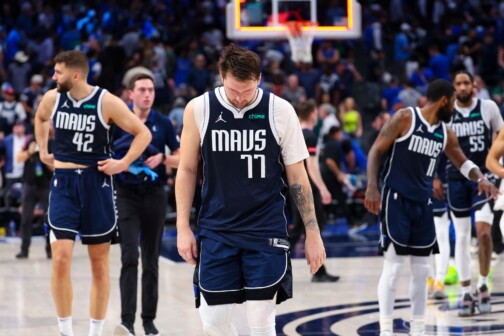The Dallas Wings have a hierarchy of attention. The headline, and even subhead, is Arike Ogunbowale. After her, Satou Sabally, Dallas’ resident unicorn, also draws plenty of eyeballs. And for reasons that aren’t always positive, Charli Collier and Awak Kuier have been in the spotlight, too.
Well down the docket is Allisha Gray, the WNBA’s best-kept secret, at least for now. It is becoming harder and harder to ignore a landmark season for Gray thus far.
Through 17 starts, she has career highs in points, rebounds, blocks, and three-point percentage. She is the Wings’ second-leading scorer at 14.5 points per game, and you can find her name on the league’s top-20 lists in various categories, including points, points per game, rebounds, blocks, and three-point percentage. The fourth overall pick in the 2017 draft is blossoming, demonstrating that WNBA development isn’t linear.
Gray’s first four years saw her go through two different coaching regimes. Fred Williams led the team from its relocation to Dallas (from Tulsa) through 2018, when Brian Agler took over. Both men gave Gray plenty of opportunities: save for the 2020 COVID-shortened season, she played in all 34 games for three straight years, including her Rookie of the Year campaign in 2017.
The problems had less to do with her, and more everything around her. The franchise lacked solid direction: in the span of eight months, the team traded its two superstars—Skylar Diggins-Smith to Phoenix and Liz Cambage to Las Vegas—before dismissing Agler following the 2020 campaign. Gray was hardly a problem, but she wasn’t impactful enough to steady the ship, either.
Then came Vickie Johnson, a move that felt like a coup at the time. She was tough, defensive-minded, a key figure on a successful squad in Las Vegas—exactly the sort of coach who figured to be able to raise the collective game of a young Wings roster. At first, Gray didn’t seem like a primary beneficiary. She started 2021 with a 23-point effort in the season opener against the Sparks before departing for the Tokyo Olympics, where she helped the USA women’s 3×3 basketball team take home gold. She returned a month later, but her game was late making the flight: she posted single-digit points and rebounds in four of her first five games back.
Things came to a head after a loss to the Aces, when Johnson took her to task publicly, saying, “Right now she doesn’t understand spacing, her jump shot is not in rhythm, she’s in her head a little bit. Now she has to relearn our system, how to play and how to move five on five versus three on three.” It would be presumptuous to point to that moment as the catalyst for what came next, but Gray’s performances perked up shortly after: in her ensuing 19 games, Gray posted double-digit points in 16 of them along with eight double-digit game scores.
Now it’s 2022, and Gray is on pace for her first All-Star appearance as Dallas’ two-way player extraordinaire. Starting with offense, Gray mirrors Ogunbowale in a few ways, mostly through a shared ability to score on multiple levels. Per Basketball-Reference, Gray has an effective field goal percentage—a metric where three-pointers are weighted more because of their extra value, giving it a more modern take on the traditional stat—of 60.7 percent on shots at the rim. From three, it’s 64.5 . Her overall eFG percentage is 55.7, good for 12th league-wide (Minnesota’s Sylvia Fowles leads at 65.1 percent). When Gray is on the floor for Dallas, the Wings’ offensive rating (which is per 100 possessions) is 108.2—an above-average to good offense. When she’s off, it plummets to a below-average 97.5. That’s the definition of a difference-maker.
Defensively, she occupies two different spaces. The rebounding is what stands out; Gray’s 6-foot frame gives her the ability to play quickly like a guard but clean glass like a traditional big. When Gray is on the court, the team is +5.3 in defensive rebounding compared to when she isn’t. Her length lets her disrupt passing lanes, resulting in a positive number of steals on/off number since Johnson took over in 2021. Opposing teams also have a lower offensive rebound percentage and offensive rating in 2022 when Gray occupies the court. Or you could just watch her: she hunts the ball like a defensive midfielder in soccer, her eyes constantly darting behind and in front.
That skill set is valuable enough in a vacuum, but it’s especially important in the context of this roster. Gray’s ability to bridge the back- and frontcourt is critical. Her size and wide-ranging skill set enable Johnson to roll out big or small lineups depending on the opposition, confident that Gray can fill in the gaps. Sometimes that means playing Ogunbowale and Marina Mabrey together and turning their jumpers loose because Gray’s ball hawking can help salvage some of the extra defensive possessions when the shots aren’t falling. Other times it’s playing Kuier alongside any of the other bigs because Gray’s three-point percentage at her size covers for those who aren’t as proficient from deep. She also facilitates Teira McCowan’s continued integration into the team dynamic; Gray’s rebounding and ability to create defensive mismatches effectively buy Dallas time to blend in their marquee offseason acquisition versus forcing her to play minutes for which McCowan is not yet ready.
Simply put, Gray is developing into a championship-level player. Win shares help us understand this better. Gray is fifth in the league in offensive win shares this year at 2.1. That puts her in rarified air among names like Breanna Stewart, Jackie Young, and Nneka Oguwumike—and, notably, ahead of Ogunbowale, whose 1.5 puts her at No. 13. And on defense, Gray’s 0.7 puts her just outside the top 20 (Stewart leads the league at 1.3). There’s every chance the latter number climbs once Gray returns from her ankle injury, which means Dallas would have a player who is both a top-five producer on offense and a top-20 stopper on defense—which is to say, a player who can be a strong piece on a championship contender someday. After signing a long-term extension last February, she’ll spend at least two more years in Dallas helping the Wings try to become exactly that.
For the first time in Gray’s WNBA career, things feel on track in Dallas. A team that had to claw its way into the postseason a year ago should make it much easier this time around. The Wings have a heading, a direction to chase. Gray’s contribution to that can’t be ignored any longer. She has become an unsung star in her sixth WNBA season, and it may not be much longer before the “unsung” label becomes obsolete. Gray’s emergence might not have been on her time. But for Dallas, it couldn’t be coming at a better one.
Author







